
DEFEXPO 2022: A Marque Of ‘Atmanirbharta’ In Defence

The Indian DefExpo 2022 was held from 18-23 October at the Mahatma Mandir Convention and Exhibition Centre in Gandhinagar, Gujarat. The present edition is India’s 12th and largest Defence Exposition, focused towards land, sea and aerial platforms/technologies including those technologies contributing to internal security.
The landmark ‘For & By India’ event, with the theme ‘Path to Pride’ was inaugurated by the Hon’ble PM of India in the historic Sabarmati River Basin. In the words of the Hon’ble PM- “this is the first defence expo where only Indian companies are participating and it features only Made in India equipment.” He also added that “DefExpo 2022 paints a picture of ‘New India’ and its capabilities”. The press release by MoD on DefExpo 2022 reiterated that the Indian Defence ecosystem has firmly emerged as the ‘sunrise sector’ for the country[1]. The mega-event was spread over four different venues and witnessed the unprecedented participation of the Armed Forces, 1340 indigenous companies including MSMEs and start-ups; investors and representation from 75 countries/33 Foreign Ministries/10 State Pavilions!
DefExpo 2022 witnessed the conclusion of 451 Agreements (more than 100% augmentation over DefExpo 2020!)- including 345 MoUs, 42 Major Announcements, 46 Product Launches and 18 Transfer of Technology agreements, worth Rs 1.53 Lakh Crore. This reflects the apt trust imposed by the Indian Government and the Indian Armed Forces in indigenous Defence expertise, technology and production.
“Invest for Defence’ was organised as an unprecedented investor outreach to amalgamate businesses and investors contributing to the Defence industry. Endorsing this effort, the Hon’ble RM stated in his address that “to increase the participation of domestic industry in the defence sector, the government has reserved 68% of the defence capital acquisition for domestic procurement for the year 2022-23, which is approximately Rs. 85,000 crores and 25% of this has been reserved for domestic private industry”.
A testimony to India’s fast-growing global footprint were the multifarious bilateral/multilateral engagements conducted on the side-lines of the event. The 2nd Edition of the India-Africa Defence Dialogue (featuring 50 African Nations and slated to ‘explore areas of convergence for mutual engagement- capacity building, training, cyber & maritime security and counter-terrorism’) as well as the Indian Ocean Region-Plus Conclave (with a 41-country participation)/Defence Ministers’ Conclave hosted by the Hon’ble RM, at the helm of other engagements by the Hon’ble Raksha Rajya Mantri, Chief of Defence Staff and Defence Secretary, were a reflection of India’s pre-eminence in global and regional affairs.
Another feather in the cap for ‘Make in India’ was the wholesome participation by the seven new Defence Public Sector Undertakings (DPSUs) which were raised in 2021 as part of the restructuring of the Ordnance Factory Board into fully Government-owned Enterprises.
Among other engagements, the Hon’ble PM announced the Fourth Positive Indigenisation List-consisting of 101 items related to the Defence Sector that will only be procured through indigenous technology. The PM also virtually laid the foundation stone of Air Force Station Deesa, approximately 160 Km North of Ahmedabad, which will plug the current geographical gap between airbases in Gujarat and Rajasthan and boost the IAF’s offensive capabilities along India’s Western Front. The PM also unveiled the HAL’s HTT-40 Trainer Aircraft and launched Mission DefSpace to address 75 identified challenges- aimed at generating disruptive and cutting-edge space solutions for the Armed Forces and consolidating India’s claim rights for future opportunities in the Space sector.
The Hon’ble RM inaugurated Manthan 2022, an event organised by MoD under Innovations for Defence Excellence-Defence Innovation Organisation (iDEX-DIO), as part of DefExpo 2022, which was aimed at bringing together the Armed Forces, corporates and start-ups to crystallize indigenous innovations for the Indian Defence Sector by showcasing capabilities, products and state-of-the-art technologies.
Technology Displayed at DefExpo 2022
In keeping with the event’s theme of self-reliance, this article will focus on wholly indigenous/indigenous-foreign Joint Venture (JV) main equipment exhibits /disruptive technologies that would define the Armed Forces’ self-reliant profile of tomorrow.
Basic Trainer Aircraft (HTT-40). As mentioned earlier in this article, the Hon’ble PM unveiled the HTT-40 during his visit to the DefExpo. The indigenous trainer aircraft, designed and developed by HAL with over 60% indigenous content, would be used for basic flying training, aerobatics, instrument flying and close-formation flights, with secondary roles of navigation and night flying. Powered by a turbo-prop engine, it is equipped with the latest avionics and boasts of unique features like running change-over of pilots, hot-refueling and short- turnaround time. The aircraft is certifiable to international military training aircraft standards. It has currently passed all Preliminary Staff Qualitative Requirements, hot weather, sea-level/cross-wind trials and user-assisted technical trials. Provisional clearance for the airworthiness of the aircraft has been received from the Centre for Military Airworthiness and Certification (CEMILAC).

HTT-40 at DefExpo:Source-raksha-anirveda.com
DARSHITA for IAF. The Dynamically Articulated Region-Specific High-Resolution Weather Guidance Tool for Aviators (DARSHITA) was exhibited as part the IAF’s Indigenisation Stall.
Armoured Platforms. Armoured Vehicles Nigam Ltd (AVNL), one of the seven DPSUs as mentioned above, showcased the Main Battle Tank (MBT) Arjun Mark-1A. The MBT is an upgrade of the ‘third-generation’ Arjun MBT, developed by DRDO’s Combat Vehicles Research & Development Establishment (CVRDE). The Mark-1A has close to 89 modifications/improvements, with approximately 50% indigenous content and with major upgrades in armament, Fire Control System, protection and transmission systems, which have accorded it simultaneous target tracking/ computing and consequent ‘hunter-killer’ (HK) capability. The Hon’ble PM formally handed over the Arjun Mark-1A to Chief of Army Staff at Chennai in February 2021 and in September the same year, an order for 118 tanks was placed for the IA, which will engage close to 200 industry players, including MSMEs, in the manufacturing process. The Mark-1A has an operational range of 450 Km and can fire a variety of ammunition including Penetration-cum-Blast /Thermobaric projectiles and ATGMs. Read more about the Arjun Mark-1A @ https://chanakyaforum.com/indias-arjun-mark-1a-vs-pakistans-vt-4-rival-chariots-of-fire/. AVNL also displayed the upgraded BMP-II Infantry Fighting Vehicle, mounted with the 5th Generation SPIKE ATGM, with a range of 5.5Km/10 Km respectively for ground/ aerial launch and the PALM-120 Loitering Munition, developed by Indian firm AVision Systems, with a range of 40 Km and an endurance of 60 minutes. DRDO also showcased the TATA 8×8 Wheeled Armoured Platform (WhAP), mounted with a 30 mm cannon, presently shortlisted along with platforms from three other indigenous firms for induction into the IA (read more @ https://chanakyaforum.com/the-new-breed-of-protected-mobility-vehicles-do-they-fit-the-bill/).
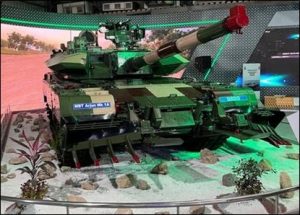
MBT Arjun Mark-1A at DefExpo:Source-janes.com
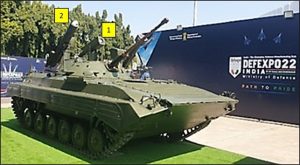
Screengrab of Upgraded BMP-II With SPIKE(1) and PALM-120(2):Source-theigmp.org
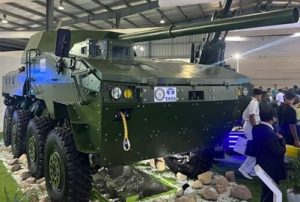
TATA WhAP at DefExpo:Source-janes.com
155mm Mounted Gun System (MGS). The 155mm, 52 caliber MGS, designed by DRDO, is mounted on a 8×8 Tatra Truck manufactured under license by Bharat Earth Movers Limited (BEML), with a 30 Kmph/80 Kmph cross-country/road speed. The gun has a modular design, shoot & scoot capability and can fire all standard NATO ammunition in all weather conditions by day/night. The MGS is also equipped with an Automatic Ammunition Handling system, Auto-Laying, all-electric drives ensuring least maintainability and failures and a Muzzle Velocity Radar. 814 MGS are to be part of the IA’s inventory. The 155mm, 52 Caliber Advanced Towed Artillery Gun System (ATAGS), a JV of DRDO and Kalyani Group along with TATA Advanced Systems Ltd, was also showcased [read more @ https://chanakyaforum.com/indias-advanced-towed-artillery-gun-system-atags/ ].
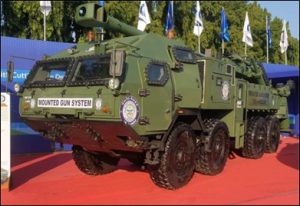
DRDO’s MGS at DefExpo
DRDO’s Missiles- BrahMos Next-Generation (NG) Air-Launched Version (ALV), Prahaar, Rudram-III, Quick-Reaction Surface-to-Air Missile (QRSAM), Medium-Range Surface-to-Air Missile (MRSAM) and ASTRA Air-to-Air Missile (AAM). DRDO has made significant strides in development of various Surface-to-Surface Missiles (SSM), SAMs and recently in AAM, including Air Launched Cruise Missiles (ALCM). These were showcased at DefExpo 2022 and some of these missiles are described here. BrahMos-NG ALV will be 40% smaller and 50% lighter than BrahMos-I, with a range of 290-300 km and speed upto Mach 3.5. Being smaller and lighter, upto 4 ALVs could be mounted on a SU-30 MKI aircraft whereas a TEJAS LCA could carry two missiles. This version is also suitable for arming the smaller MiG-29K or Mirage-2000 fighter aircraft. The missile is likely to be ready for induction in 2024, should development progress as planned. Prahaar (‘Strike’) is a road-mobile, all-terrain, all-weather, single-stage, solid-fuelled SSM with an effective strike range from 60-150 km. This SSM has been covered in detail @ https://chanakyaforum.com/indias-new-missiles-brahmastras-in-the-quiver/ . This Tactical Ballistic Missile (TBM) can carry conventional High Explosive (HE), nuclear or sub-munition payloads and has been developed to replace the Prithvi SSM, which has a range of 150 km. Prahaar was successfully test-fired on 20 September 2018. Rudram-III is the latest of three variants of India’s first Air-to-Surface New Generation Anti-Radiation Missile (NGARM) for the IAF that can be launched from varying attitudes at stand-off distances for destruction of surveillance radars, tracking and communication systems. The Rudram-III has an operational range of 550 Km and can fly at altitudes from 500m-15 Km. The Rudram-I was successfully test-fired in Oct 2020 and will be inducted into the IAF in the near future. The indigenous QRSAM has a range of 3-30 km, flight altitude of 30m-10 Km and max speed of Mach 4.7! It is designed for protection of armoured columns against aerial treats. The maiden test-firing of the QRSAM took place in November 2020. Six flight tests were subsequently completed on 8 September 2022, where the QRSAM managed to intercept high-speed aerial targets with pinpoint accuracy under long-range medium-altitude and short-range high-altitude conditions, in quick succession. The tests were carried out in final deployment configuration with all indigenously developed subsystems. The first deliverable firing unit of the MRSAM was handed over by the Hon’ble RM to the IAF in September 2021. The MRSAM, which comes in Mark-I, Mark-II and New-Generation (NG) variants, is the outcome of a JV between DRDO and Israel Aerospace Industries (IAI). The MRSAM is the land-based version of the Barak-8 SAM and is meant for medium-range AD for the Indian Army (IA) and the IAF. The MRSAM-NG, with close to 70% indigenous content has a range of 70 km and max operating altitude of 20 Km, which essentially fills the medium-range AD interceptor gap in the inventory. The missile completed its development trials when the IA version was successfully test-fired on 30 March 2022. Both QRSAM and MRSAM have been earlier covered @ https://chanakyaforum.com/mr-sam-boosting-efficacy-of-indias-air-defence/. The ASTRA, India’s first Beyond-Visual-Range AAM is designed to be mounted on IAF’s fighter jets for engagement of highly manoeuverable, supersonic aerial targets over ranges from 10-110 Km at Mach 4.5. The missile is being developed in multiple variants to meet specific requirements, with the Mark-3 version capable of ranges upto 350 Km. The AAM has been integrated with SU-30 MKI. A contract for 250 AAM for the IAF/IN was inked in June this year. Read more @ https://chanakyaforum.com/iafs-vajrayudha-the-astra-air-to-air-missile/ .

BrahMos-NG at DefExpo:Source-thehindu.com

Screengrab of Prahaar & Rudram-III at DefExpo:Source-YouTube/Indian Defence Analysis
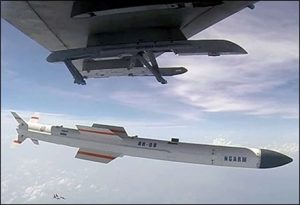
Rudram NGARM Launched from a Su30-MKI Aircraft:Source- economictimes.indiatimes.com
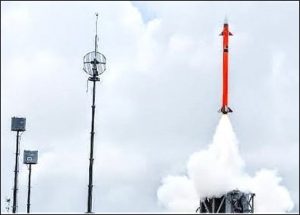
Army Version of MRSAM Being Test-Fired:Source-newindianexpress.com
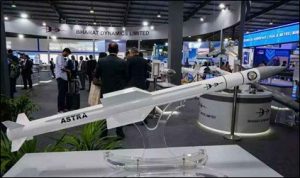
ASTRA at DefEXpo:Source-navbharattimes.indiatimes.com
BrahMos Land-Based and Ship-Based Weapons Complex (LBWC/SBWC). The BrahMos LBWC comprises of 4-6 Mobile Autonomous Launchers (MAL) controlled by a Mobile Command Post (MCP) and a Mobile Replenishment Vehicle. The SBWC allows the BrahMos to be launched in inclined/vertical launch configuration (ILC/VLC) based on the ship type. The VLC enhances the ship’s stealth capabilities as the missiles are positioned under the deck and are not exposed. The Universal Vertical Launcher (UVLM) being used in these ships has been developed by BrahMos Aerospace.
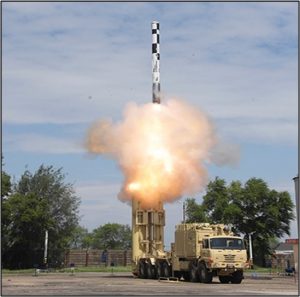

BrahMos LBWC/SBWC:Source-brahmand.com/defexpo22
ATGMs. Bharat Dynamics Ltd (BDL) showcased the Sangramika ATGM System which mounts the AMOGHA-III ATGM on a Light Specialist Vehicle of Ashok Leyland. This enables quick deployment of the man-portable ATGM. DRDO’s Semi-Active Mission Homing (SAMHO) ATGM for MBT Arjun with a 5 Km range was also displayed. Also on display were DRDO’s Man-Portable (MP) ATGM, derived from the NAG ATGM and equipped with an Imaging Infra-Red Seeker, with an effective range of 2.5 Km; as well as the HELINA, the helicopter-launched extended range variant of the NAG ATGM, with a range of 7-10 Km.

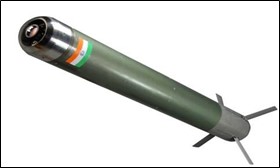
HELINA & SAMHO ATGMs:Source-indiandefencenews.in/drdo.gov.in
Sanharika Short-Range AD (SHORAD) Weapon System. The Sanharika is a LASER Beam Riding Missile (LRBM) developed by BDL in a JV with Thales, UK. The system is mounted on the ARMADO, a light strike vehicle from Mahindra Defence Systems Ltd, thus enabling speedier deployment.
Advanced Loitering System (ALS-50). Tata Advanced System Ltd displayed the ASL, an autonomous loitering munition, designed for Vertical Takeoff/Landing (VTOL). It has a payload capacity of 23 Kg and can take off like a quadcopter before transitioning into fixed-wing mode for sustained flight. It can operate from high altitude/difficult terrain. The ALS successfully struck a target during live tests at Pokhran, Rajasthan in September and is likely to be inducted soon.

ALS-50 at DefExpo:Source-swarajyamag.com
TAL Torpedo. The experimental Advanced Light Torpedo (TAL)-XP is the IN’s first indigenous anti-submarine torpedo, developed by DRDO’s Naval Science and Technological Laboratory. This processor-based torpedo can be launched from ships/submarines/aerial platforms and has with solid-state electronics, digital technology and an integrated Active/Passive homing sensor package. The TAL has an operational range/depth of 19Km/540m respectively and a max speed of 61 Kmph. Its key design features are manoeuvrability and ability to transition from warm to cold medium to ensure a hunt and kill. On 8 March 2021, the IN successfully cleared the TAL’s maiden flight-trial with a parachute system from the Il-38 maritime aircraft.

TAL at DefExpo:Source-firstpost.com
D4 Counter-Drone System (CDS). The DRDO-developed D4 CDS comprises a drone detection/tracking radar, day/night camera with LRF for detection/tracking of drones, communication channel detection/jamming system (soft kill), GPS jamming/spoofing System (soft kill), LASER directed energy weapon system (hard kill) and command & control center (C3) with integral power source. DRDO claims the system can detect/deactivate drones of any size within a 4-km radius. This system has been deployed multiple times since 26 January 2020 and successfully downed a hostile drone while deployed at Jammu’s Airbase in July last year.
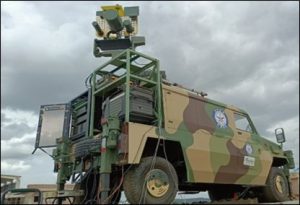
DRDO’s CDS:Source-psuconnect.in
Unmanned Ground Vehicles (UGV). The Titan UGV, developed by Gridbots Technologies Pvt Ltd, was displayed mounted with the AMOGHA-III ATGM, developed by BDL. This gives the Titan the capability to engage armoured targets in top/direct attack mode from ranges upto 2 Km, at speeds of upto 30 Km and thermal signature detection range upto 20 Km, making it a potent anti-tank platform. Kalyani Group also showcased their Unmanned Guided Vehicle (UGUV), capable of operating on battery/motor for 6/14 hours respectively. It has an operational range of 3 Km and can carry a load of 500 kg. The UGUV has multiple sensors for mapping/routing and obstacle-detection, and can be used for explosive detection/neutralization of IEDs.

Titan UGV with AMOGHA-III ATGM:Source-theigmp.org

Kalyani Group’s UGUV:Source-vayuaerospace.in
Conclusion
DefExpo 2022 represented a quantum leap in India’s Defence indigenisation prowess and was ostensible in showcasing the growing strength of the Indian Defence Industry, including DPSUs, major private vendors, MSMEs and startups. Showcasing the Nation’s Defence industrial base would significantly facilitate the twin aims of proving a fillip to existing /noveau players as well as boost India’s standing as a major Defence exporter in the global market.
***************************************************************************************************************
Disclaimer
The opinions expressed in this article are the author’s own and do not reflect the views of Chanakya Forum. All information provided in this article including timeliness, completeness, accuracy, suitability or validity of information referenced therein, is the sole responsibility of the author. www.chanakyaforum.com does not assume any responsibility for the same.
Chanakya Forum is now on . Click here to join our channel (@ChanakyaForum) and stay updated with the latest headlines and articles.
Important
We work round the clock to bring you the finest articles and updates from around the world. There is a team that works tirelessly to ensure that you have a seamless reading experience. But all this costs money. Please support us so that we keep doing what we do best. Happy Reading
Support Us





















POST COMMENTS (0)